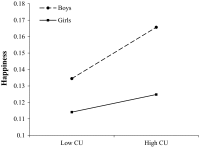The Association Between Callous-Unemotional Traits, Externalizing Problems, and Gender in Predicting Cognitive and Affective Morality Judgments in Adolescence
- PMID: 27334400
- PMCID: PMC4982886
- DOI: 10.1007/s10964-016-0527-x
The Association Between Callous-Unemotional Traits, Externalizing Problems, and Gender in Predicting Cognitive and Affective Morality Judgments in Adolescence
Abstract
Morality deficits have been linked to callous-unemotional traits and externalizing problems in response to moral dilemmas, but these associations are still obscure in response to antisocial acts in adolescence. Limited evidence on young boys suggested that callous-unemotional traits and externalizing problems were associated with affective but not cognitive morality judgments. The present study investigated these associations in a community sample of 277 adolescents (M age = 15.35, 64 % females). Adolescents with high callous-unemotional traits showed deficits in affective but not cognitive morality, indicating that they can identify the appropriate moral emotions in others, but experience deviant moral emotions when imagining themselves committing antisocial acts. Externalizing problems and male gender were also strongly related to deficits in affective morality, but they had smaller associations with deficits in cognitive morality too. Implications for treatment and the justice system are discussed.
Keywords: Callous–unemotional traits; Externalizing problems; Gender; Morality judgments.
Figures
Similar articles
-
Knowing right from wrong, but just not always feeling it: relations among callous-unemotional traits, psychopathological symptoms, and cognitive and affective morality judgments in 8- to 12-year-old boys.Child Psychiatry Hum Dev. 2013 Dec;44(6):709-16. doi: 10.1007/s10578-013-0363-0. Child Psychiatry Hum Dev. 2013. PMID: 23378186
-
Moral disengagement and callous-unemotional traits: A longitudinal study of Italian adolescents with a disruptive behaviour disorder.Crim Behav Ment Health. 2017 Dec;27(5):514-524. doi: 10.1002/cbm.2019. Epub 2016 Sep 13. Crim Behav Ment Health. 2017. PMID: 27624802
-
The effect of empathy and callous-unemotional traits on externalizing behavior in juvenile offenders: The mediating role of moral disengagement.Int J Soc Psychiatry. 2025 Sep;71(6):1141-1154. doi: 10.1177/00207640251328818. Epub 2025 Mar 31. Int J Soc Psychiatry. 2025. PMID: 40163024 Free PMC article.
-
Does the Interplay of Callous-Unemotional Traits and Moral Disengagement Underpin Disruptive Behavior? A Systematic Review.Adolesc Health Med Ther. 2020 Feb 3;11:9-20. doi: 10.2147/AHMT.S151699. eCollection 2020. Adolesc Health Med Ther. 2020. PMID: 32099503 Free PMC article. Review.
-
Research review: the importance of callous-unemotional traits for developmental models of aggressive and antisocial behavior.J Child Psychol Psychiatry. 2008 Apr;49(4):359-75. doi: 10.1111/j.1469-7610.2007.01862.x. Epub 2008 Jan 21. J Child Psychol Psychiatry. 2008. PMID: 18221345 Review.
Cited by
-
Callous-Unemotional Traits, Moral Disengagement, and Prosocial and Bullying Behaviors in Adolescence: Disentangling Between- and Within-Person Associations.J Youth Adolesc. 2025 Aug 10. doi: 10.1007/s10964-025-02235-3. Online ahead of print. J Youth Adolesc. 2025. PMID: 40783891
-
Associated functional network connectivity between callous-unemotionality and cognitive and affective empathy.J Affect Disord. 2022 Dec 1;318:304-313. doi: 10.1016/j.jad.2022.08.103. Epub 2022 Sep 2. J Affect Disord. 2022. PMID: 36063973 Free PMC article.
-
When empathy leads to aggression: The effects of empathy on punitive attitudes towards aggressors.Br J Soc Psychol. 2025 Jul;64(3):e12907. doi: 10.1111/bjso.12907. Br J Soc Psychol. 2025. PMID: 40411157 Free PMC article.
-
Callous-Unemotional Traits Moderate Anticipated Guilt and Wrongness Judgments to Everyday Moral Transgressions in Adolescents.Front Psychiatry. 2021 Mar 5;12:625328. doi: 10.3389/fpsyt.2021.625328. eCollection 2021. Front Psychiatry. 2021. PMID: 33762977 Free PMC article.
-
Is feeling bad good enough? Ethical guilt and callous-unemotional traits in childhood.Res Child Adolesc Psychopathol. 2022 Aug;50(8):1041-1053. doi: 10.1007/s10802-022-00909-1. Epub 2022 Jun 6. Res Child Adolesc Psychopathol. 2022. PMID: 35666337
References
-
- Achenbach T. Manual for the Youth Self-Report and 1991 Profile. Burlington, VT: University of Vermont, Department of Psychiatry; 1991.
-
- Archer J. Sex differences in aggression in real-world settings: A meta-analytic review. Review of General Psychology. 2004;8(4):291–322. doi: 10.1037/1089-2680.8.4.291. - DOI
-
- Asscher JJ, van Vugt ES, Stams GJJM, Dekovic M, Eichelsheim VI, Yousfi S. The relationship between juvenile psychopathic traits, delinquency and (violent) recidivism: A meta-analysis. Journal of Child Psychology and Psychiatry. 2011;52(11):1134–1143. doi: 10.1111/j.1469-7610.2011.02412.x. - DOI - PubMed
MeSH terms
LinkOut - more resources
Full Text Sources
Other Literature Sources


